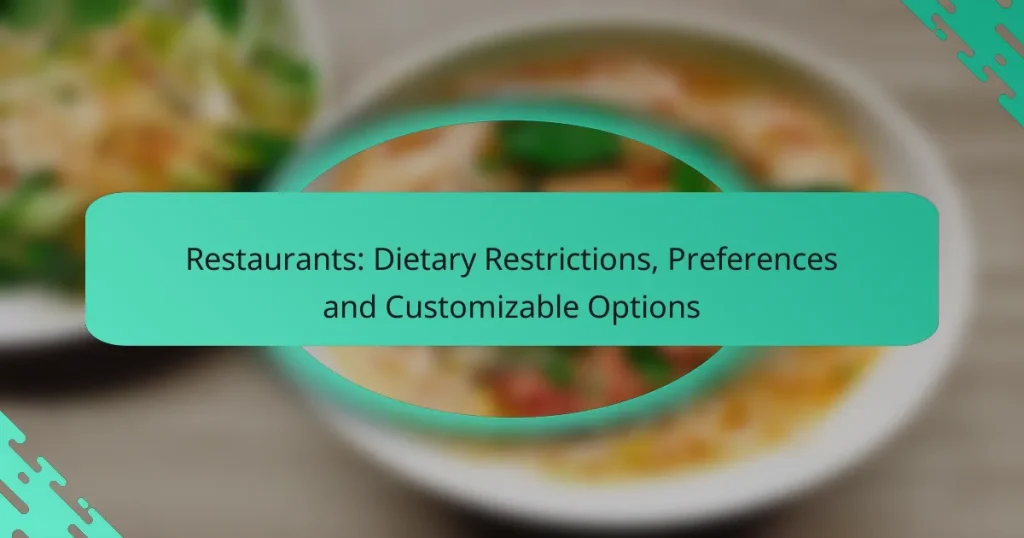Many restaurants today are dedicated to accommodating dietary restrictions and preferences, offering customizable options that enhance the dining experience. By providing clear labeling and special menus, these establishments ensure that all patrons can enjoy their meals without compromise. To discover suitable dining options, utilize online resources and local recommendations that highlight restaurants committed to dietary inclusivity.

How do restaurants accommodate dietary restrictions in Los Angeles?
Restaurants in Los Angeles often provide a variety of options to accommodate dietary restrictions, ensuring that all customers can enjoy their meals. Many establishments offer customizable dishes, special menus, and clear labeling to help diners make informed choices.
Gluten-free options
Many restaurants in Los Angeles cater to gluten-free diets by offering dedicated gluten-free menus or clearly marking gluten-free items on their regular menus. Options may include gluten-free pasta, bread, and desserts, allowing those with celiac disease or gluten sensitivity to dine out safely.
When ordering, it’s advisable to ask about cross-contamination practices, as some kitchens may prepare gluten-free items alongside gluten-containing foods. Look for establishments that specialize in gluten-free cuisine for a wider selection.
Vegan and vegetarian menus
Vegan and vegetarian options are widely available in Los Angeles, with many restaurants featuring dedicated menus or sections for plant-based dishes. These can range from salads and grain bowls to innovative meat alternatives made from ingredients like soy, legumes, and vegetables.
When dining out, inquire about the use of animal-derived ingredients, such as dairy or eggs, as some dishes may not be fully vegan despite being labeled as vegetarian. Popular vegan-friendly restaurants often highlight their commitment to plant-based dining, making it easier to find suitable options.
Allergen-friendly dishes
Restaurants in Los Angeles are increasingly aware of food allergies and often provide allergen-friendly dishes. Many places will accommodate requests for modifications to avoid common allergens like nuts, dairy, and shellfish.
It’s essential to communicate your dietary restrictions clearly to the staff, as they can guide you to safe options and inform you about potential cross-contact. Some establishments may even have allergen-free menus or dedicated preparation areas to ensure safety for sensitive diners.

What customizable options are available at local restaurants?
Local restaurants often provide a variety of customizable options to accommodate dietary restrictions and personal preferences. These options can enhance the dining experience by allowing patrons to tailor their meals to their specific needs.
Ingredient substitutions
Many restaurants offer ingredient substitutions to cater to dietary restrictions such as allergies or preferences like vegetarianism. For example, you might replace dairy with plant-based alternatives or swap out gluten-containing grains for gluten-free options. Always ask your server for available substitutions to ensure your meal meets your dietary requirements.
When considering substitutions, be aware that some changes may affect the dish’s overall flavor or texture. It’s wise to inquire about how these adjustments might alter the meal, especially if you are trying something new.
Portion size adjustments
Portion size adjustments are another common customizable option at local eateries. Many restaurants allow you to request smaller or larger portions based on your appetite or dietary goals. This can be particularly helpful for those looking to manage caloric intake or share dishes with others.
Keep in mind that not all restaurants may accommodate portion changes, so it’s best to ask in advance. If you’re unsure, consider ordering a smaller plate or appetizer to start, which can be a good way to gauge your hunger without committing to a full meal.
Flavor profile modifications
Flavor profile modifications enable diners to adjust the seasoning and preparation of their meals. This could involve requesting less salt, adding extra spices, or choosing a different sauce. Such modifications can enhance your enjoyment, especially if you have specific taste preferences or dietary restrictions.
When making flavor adjustments, communicate clearly with your server about your preferences. Some restaurants may have signature sauces or seasonings that they recommend, so don’t hesitate to ask for suggestions that align with your desired flavor profile.

How can I find restaurants that cater to specific dietary preferences?
To find restaurants that cater to specific dietary preferences, start by using online resources and local recommendations. Look for places that clearly list their menu options and dietary accommodations, ensuring they meet your needs.
Online review platforms
Online review platforms like Yelp, TripAdvisor, and Google Reviews allow users to filter restaurants based on dietary restrictions such as vegan, gluten-free, or nut-free options. Check the reviews for mentions of how well the restaurant accommodates these needs, as customer experiences can provide valuable insights.
When using these platforms, pay attention to the number of reviews and the overall ratings. A restaurant with a high volume of positive feedback regarding dietary accommodations is likely to be more reliable.
Restaurant websites
Most restaurants have websites that detail their menu offerings and any dietary accommodations they provide. Look for sections labeled “Menu,” “Dietary Options,” or “Allergies” to find relevant information. Some establishments even offer customizable options directly on their menus.
Additionally, many restaurants are now including allergen information and dietary symbols (like a leaf for vegan) on their menus, which can help you make informed choices before visiting.
Local food blogs
Local food blogs often feature reviews and recommendations for restaurants that cater to specific dietary preferences. These blogs can provide in-depth insights and personal experiences that you may not find on larger review platforms.
Search for blogs that focus on your dietary needs, as they may highlight hidden gems in your area. Following local food bloggers on social media can also keep you updated on new restaurant openings and special dietary events.

What are the benefits of customizable dining experiences?
Customizable dining experiences offer significant advantages by allowing patrons to tailor their meals to fit personal preferences and dietary needs. This flexibility enhances overall dining satisfaction and fosters a more inclusive environment for diverse dietary requirements.
Enhanced customer satisfaction
When diners can customize their meals, they are more likely to enjoy their dining experience. This satisfaction stems from having control over ingredients, flavors, and portion sizes, which can lead to repeat visits and positive word-of-mouth recommendations.
Restaurants that prioritize customization often receive higher ratings and reviews, as guests appreciate the effort to accommodate their unique tastes. Simple options, such as choosing sauces or sides, can significantly elevate a meal’s appeal.
Increased dietary compliance
Customizable dining is particularly beneficial for individuals with dietary restrictions, such as allergies or intolerances. By allowing guests to specify their needs, restaurants can help ensure that meals are safe and enjoyable, reducing the risk of adverse reactions.
For example, a diner with gluten intolerance can request gluten-free options, while someone following a vegan diet can choose plant-based ingredients. This level of accommodation not only meets customer needs but also aligns with growing health trends.
Broader menu appeal
A customizable menu can attract a wider range of customers, as it caters to various dietary preferences and restrictions. By offering a base dish with multiple add-ons or substitutions, restaurants can appeal to health-conscious diners, families, and food enthusiasts alike.
For instance, a build-your-own salad bar allows patrons to select from a variety of greens, proteins, and dressings, ensuring that everyone finds something they enjoy. This approach can enhance the restaurant’s reputation as a versatile dining option in the community.

How do restaurants ensure food safety for dietary restrictions?
Restaurants prioritize food safety for dietary restrictions by implementing strict protocols to manage allergens and prevent cross-contamination. These measures are essential to protect customers with food allergies and intolerances, ensuring their dining experience is safe and enjoyable.
Staff training on allergens
Staff training on allergens is crucial for maintaining food safety in restaurants. Employees should be educated about common allergens, such as nuts, gluten, dairy, and shellfish, and how to identify them in menu items. Regular training sessions can help reinforce this knowledge and keep staff updated on best practices.
Additionally, clear communication between front-of-house and kitchen staff is vital. When a customer alerts staff about a dietary restriction, the information must be relayed accurately to the kitchen to prevent any mistakes in food preparation.
Cross-contamination prevention measures
Preventing cross-contamination is a key aspect of ensuring food safety for those with dietary restrictions. Restaurants should establish designated areas for preparing allergen-free meals and use separate utensils and equipment to avoid mixing ingredients. This practice minimizes the risk of allergens inadvertently entering safe dishes.
Regular cleaning and sanitizing of surfaces, tools, and equipment is also essential. Restaurants should implement a cleaning schedule that includes high-touch areas and food prep zones, ensuring that all staff understand the importance of these measures in protecting customers with dietary needs.

What are the challenges restaurants face with dietary restrictions?
Restaurants encounter several challenges when accommodating dietary restrictions, including ingredient sourcing, menu design, and staff training. These obstacles can complicate operations and affect customer satisfaction if not managed effectively.
Ingredient sourcing difficulties
One major challenge for restaurants is sourcing ingredients that meet various dietary restrictions. For example, gluten-free options require specific grains and flours that may not be readily available from all suppliers. Additionally, restaurants must ensure that these ingredients are free from cross-contamination, which can complicate sourcing further.
Restaurants often face limited availability of specialty items, such as vegan cheese or nut-free alternatives, which can lead to inconsistent menu offerings. Establishing relationships with reliable suppliers who specialize in these ingredients can help mitigate these issues.
To navigate ingredient sourcing effectively, restaurants should consider creating a list of trusted suppliers and regularly reviewing their inventory to ensure they can meet customer needs. Regular communication with suppliers about upcoming trends and demands can also be beneficial.


